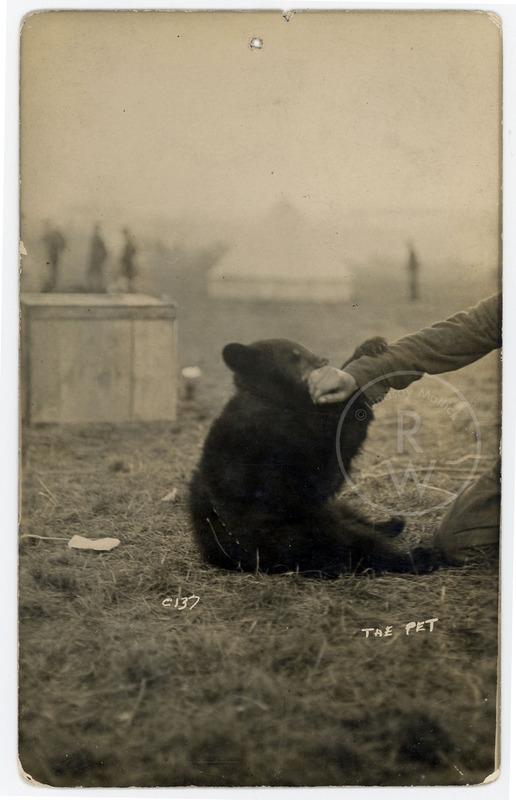The Real Winnie-the-Pooh
Winnie-the-Pooh the fun-loving star of page and screen for decades is about to be discovered by a whole new crop of fans in the soon to be released movie Christopher Robin. While audiences will learn what happens when Christopher Robin grows up, many may not know the true-life story of the bear that inspired the honey-loving animated great.

“Winnie in camp,” Remembering the Real Winnie: The World's Most Famous Bear Turns 100, accessed July 31, 2018,
Winnie-the-Pooh, as we know and love today, is based on a female Canadian black bear that was the mascot of the 2nd Canadian Infantry Brigade during World War I. That’s right, Winnie-the-Pooh is based on a Canadian bear.
Harry Colebourn, a young veterinarian from Winnipeg, Manitoba, who enlisted for service, was on route to Europe when his journey brought him to White River, Ontario. Soldiers would often travel for many days by train throughout Canada before reaching ships on the east coast of Canada. While stopped in White River, Harry learned about a young female black bear cub in town.
Weeks before the train had rolled into town, a hunter had killed the young bear cub’s mother, and a trapper had captured the cub and brought it to town to look after it. Harry paid $20 and figured that the bear could be the regimental pet. He named the bear Winnipeg after his hometown or Winnie for short.
On the train and across the ocean, Harry and the bear went. Winnie became so tame while with Harry that the bear was often paraded around as if it were no different than having a cat or dog for a pet. Winnie was reported to sleep every night under Harry’s bunk.
As the relationship between Harry and Winnie grew, the possibility of deployment to the front lines of war in France was imminent. The trenches of Europe were no place for the bear from White River. Harry knew that the danger he faced was immense, and there was no way to guarantee Winnie’s safety.
Before shipping out the front lines Harry gifted Winnie to the London Zoo. This act which guaranteed Winnie’s safety would also bring the bear from White River to immortality.
Winnie was so tame from the relationship with Harry and the rest of the soldiers in the regiment, that the London Zoo allowed visitors to get up close and personal with the Canadian bear. Visitors could have the chance to walk into Winnie’s cage, feed her a combination of corn syrup and condensed milk, or even ride on her back around Winnie’s pen. The public notoriety of this gentle fun loving bear from Canada attracted many guests to the zoo for years after World War I.
One of those regular guests was the Milne family. Author A.A. Milne would bring his son Christopher Robin to the zoo, and young Christopher Robin grew quite fond of the black bear named Winnie. After repeated visits to the zoo and spending ample time with the bear, Christopher Robin named his stuffed bear after Winnie, and the pieces to the story of Winnie-the-Pooh had fallen into place.
The love that his son had for this bear from Canada is what inspired A.A. Milne to write his first book Winnie-the-Pooh which was published in 1926. Based on the stuffed animals Christopher Robin had, and inspired by the many interactions Christopher Robin had at the London Zoo with Winnie the bear from Canada, the many journeys that readers and moviegoers would have for decades to come had begun.
Filled with whimsy, imagination, and pure joy, Milne followed up his first book with 1928’s The House at Pooh Corner.
Winnie the bear would live for twenty years at the London Zoo. Visitors of all ages would marvel at the bear from Canada, and soon with the publication of the Milne books, the bear that captured the imagination of zoo attendees would be replaced with a yellow, honey-loving bear.
Harry Colebourn would survive World War I and eventually return to his hometown of Winnipeg, Manitoba in 1920. He would go on to have a lengthy career as a veterinarian, eventually dying on September 24th, 1947.
Winnie, the bear from White River, Ontario would live for twenty years at London Zoo, dying on December 5th, 1934. The tale of Winnie the bear, an orphaned cub who was regimental pet and inspiration for the famous Winnie-the-Pooh is documented by Ryerson University Library and Archives. After you see the movie Christopher Robin, check out the real story of the bear who inspired the tales at TheRealWinnie.Ryerson.ca.
